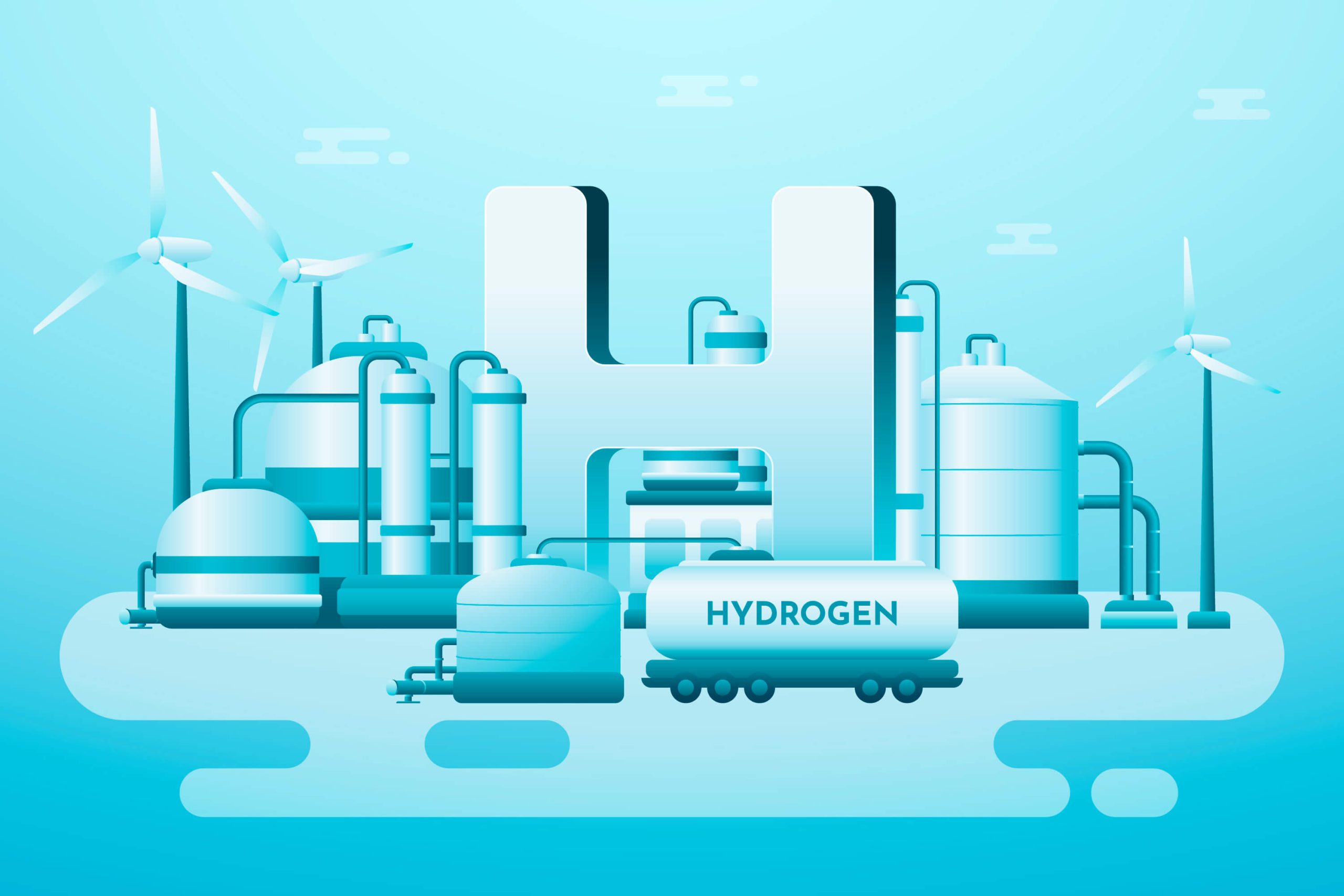The quest for sustainable energy solutions has led to the exploration of hydrogen as a viable alternative to fossil fuels. Hydrogen is a clean-burning fuel with the potential to decarbonize a wide range of industries, including transportation, power generation, and manufacturing. However, not all hydrogen is created equal. The two most common types of hydrogen are blue hydrogen and green hydrogen.
The debate often circles around blue hydrogen vs green hydrogen. While both present a shift from conventional fuel sources, they come with distinct production methods and environmental footprints.
What Is Green Hydrogen?
Green hydrogen is produced by electrolyzing water using renewable energy sources such as solar energy or wind power. This process separates water into hydrogen and oxygen, with the former being captured for use as fuel. The green hydrogen vs blue hydrogen debate often tilts in favor of green due to its zero-emission production process. Countries like Germany and Australia are investing heavily in green hydrogen technology, eyeing a substantial reduction in greenhouse gas emissions.
What Is Blue Hydrogen?
On the flip side, blue hydrogen is derived from natural gas through steam methane reforming (SMR), where carbon capture and storage (CCS) technology is utilized to capture and store the emitted carbon dioxide. This blue vs green hydrogen scenario highlights blue hydrogen as a transitional solution, which although reduces carbon emissions compared to traditional fossil fuels, still has an associated carbon footprint.
Also Read: What is green hydrogen used for
What Is The Difference Between Green Hydrogen And Blue Hydrogen?
The main difference between green hydrogen and blue hydrogen is the source of energy used to produce them. Green hydrogen is produced using renewable energy sources, while blue hydrogen is produced using fossil fuels. This difference results in significant differences in the environmental impact of the two types of hydrogen.
Green hydrogen is the most sustainable type of hydrogen, as it produces zero greenhouse gas emissions. However, it is currently more expensive to produce than blue hydrogen.
Blue hydrogen is less expensive to produce than green hydrogen, but it still produces some greenhouse gas emissions. The amount of emissions depends on the efficiency of the carbon capture and storage (CCS) technology used.
Delving into the difference between green hydrogen and blue hydrogen, green hydrogen emerges as the more sustainable choice due to its zero-emission production. The blue hydrogen vs green hydrogen comparison further extends to the scalability and long-term viability, where green hydrogen, powered by inexhaustible renewable resources, stands out.
Below is a comparative table illustrating the difference between blue hydrogen and green hydrogen:
Aspect | Green Hydrogen | Blue Hydrogen |
| Production Process | Electrolysis using renewable energy | Steam Methane Reforming with CCS |
| Carbon Emissions | Zero | Reduced, but present |
| Scalability | High, with renewable energy expansion | Limited by natural gas availability and CCS capacity |
| Long-term Sustainability | High | Moderate to Low |
| Cost | More Expensive | Less Expensive |


How Quickly Can We Shift To Hydrogen Fuels?
The pace at which we transition to hydrogen fuels largely hinges on cost of hydrogen production, the availability of renewable energy sources, technological advancements and infrastructural development. Green vs blue hydrogen transition also depends on the global investment in renewable energy sources. Countries like Japan and the European Union are setting ambitious targets to incorporate hydrogen into their energy mix within the next few decades.
However, there is a growing consensus that hydrogen will play an important role in the global energy transition. The International Energy Agency (IEA) has stated that hydrogen could account for 20% of global energy demand by 2050.
What Are The Advantages Of Green Hydrogen Over Other Types Of Hydrogen?
The green hydrogen vs blue hydrogen debate brings forth several advantages of green hydrogen. Primarily, its production is entirely clean, aiding in the global fight against climate change. Additionally, the difference between green hydrogen and blue hydrogen extends to the long-term economic benefits, with green hydrogen promising a future of energy security, job creation, and industrial competitiveness.
Green Hydrogen Has A Number Of Advantages Over Other Types Of Hydrogen, Including:
- It is the most sustainable type of hydrogen, as it produces zero greenhouse gas emissions.
- It can be produced from a variety of renewable energy sources, such as solar, wind, and hydro power.
- It is versatile and can be used in a wide range of applications, including transportation, power generation, and manufacturing.
Conclusion
The blue hydrogen vs green hydrogen discussion illuminates the crucial role of hydrogen as a future energy carrier. However, green hydrogen outshines blue in terms of environmental sustainability and long-term potential. The transition may require substantial investment upfront, but the payoff in a cleaner, more sustainable energy future is well worth the effort.
Frequently Asked Questions About Blue Hydrogen Vs Green Hydrogen
1) Is Green Hydrogen Better Than Blue Hydrogen?
Yes, green hydrogen is better owing to its zero-emission production process and long-term sustainability. Blue hydrogen still produces some greenhouse gas emissions, even though it is less than traditional methods of producing hydrogen.
2) What Are The Uses Of Green Hydrogen?
Green hydrogen can be used in a wide range of applications, including:
- Transportation: Green hydrogen can be used to power fuel cell electric vehicles (FCEVs). FCEVs produce zero tailpipe emissions and have a longer range than battery electric vehicles (BEVs).
- Power generation: Green hydrogen can be used to generate electricity in gas turbines or combined cycle power plants. This can help to reduce our reliance on fossil fuels for power generation.
- Manufacturing: Green hydrogen can be used as a feedstock in a variety of industrial processes, such as the production of ammonia and fertilizers.
3) What Are The Other Types Of Hydrogen?
Besides green and blue, there’s grey hydrogen (produced from natural gas without carbon capture) and turquoise hydrogen (produced via methane pyrolysis).
The other types of hydrogen are:
- Grey hydrogen: Grey hydrogen is produced using fossil fuels without carbon capture and storage (CCS) technology. This is the most common type of hydrogen produced today, but it is also the most polluting.
- Brown hydrogen: Brown hydrogen is produced using coal without CCS technology. It is the most polluting type of hydrogen.
- Pink hydrogen: Pink hydrogen is produced using nuclear power. It is a low-carbon type of hydrogen, but it produces radioactive waste.
- Yellow hydrogen: Yellow hydrogen is produced using solar energy and biomass. It is a low-carbon type of hydrogen, but it is less efficient than green hydrogen.
4) Which Type Of Hydrogen Is The Future?
Green hydrogen holds the promise of a sustainable energy future due to its environmental and economic advantages in the blue vs green hydrogen comparison. The blue hydrogen vs green hydrogen dialogue is a stepping stone towards discerning the sustainable energy pathways. As nations rally towards lowering carbon emissions, the spotlight on green hydrogen grows brighter, marking it as the cornerstone of a clean energy transition.









